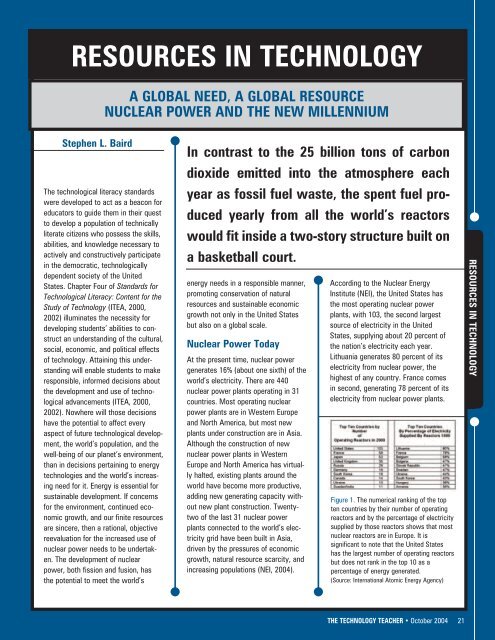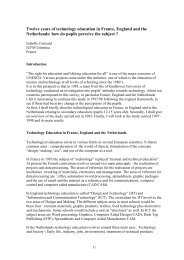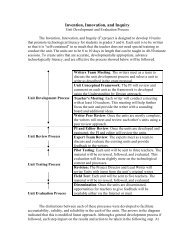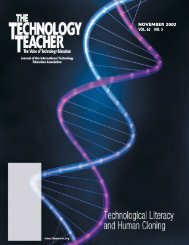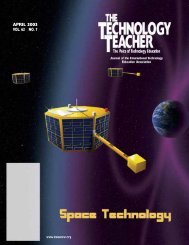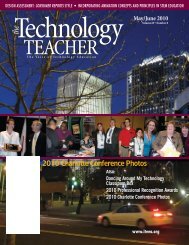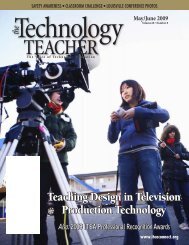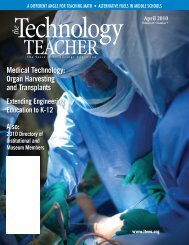IDSAan item is selected for deletion, <strong>and</strong> awarning message is given, similarwarning messages should be deliveredwhen an irrevocable action is input bythe user.Are “cause <strong>and</strong> effect” actionsvisualized?Each input by the user or change inthe behavior of the program should beaccompanied by a correspondingchange in the appearance of the interface.This is often achieved by arollover, sometimes accompanied byan audible tone, once an interface isengaged. A “current selection” shouldbe displayed with some visual contrast,<strong>and</strong> specific states should bedisplayed in a consistent, clear, <strong>and</strong>unambiguous manner.Are metaphors appropriately used?There are situations where an interfacecan be more easily understood bythe use of a metaphor. By resemblinga commonplace system, such as thecontrols on a tape deck, an interface’sfunctionality may be quickly familiarized.Identify any metaphors used <strong>and</strong>conclude if they are used consistentlythrough the product’s interface.Will users be able to recover from anerror?It is inevitable that someone will hitthe wrong button. Ascertain if anysuch action can be undone. Certaininterface functions should have aCancel button or Undo feature. Actionsthat are irreversible, like “overwriting afile,” should require a user to make anexplicit commitment. These safetynets will give novice users a realsense of comfort.Does the interface have a sense ofaesthetics?Because users interact with h<strong>and</strong>heldscreen interfaces at a close <strong>and</strong> personallevel, the interface family shouldhave a sense of beauty, <strong>and</strong> at thevery least not be ugly. Determine ifthe organization of the interfaceappears refined. Ask questions like,“are the colors harmonious, is the typelegible, <strong>and</strong> are the graphics clear<strong>and</strong> consistent?” Also note if usershave the ability to customize thedisplay of the interface, i.e. changethe colors or type font to suit theirown sense of aesthetics.ConclusionSeveral important concepts can berealized by examining the issues relevantto h<strong>and</strong>held communication interfaces<strong>and</strong> their design. Additionalprinciples or “heuristics” can be foundon the Web sites of usability advocatesJakob Nielsen <strong>and</strong> Bruce “Tog”Tognazzini. Having an underst<strong>and</strong>ing ofthese concepts, considering the constraintsof h<strong>and</strong>held communicationinterfaces, <strong>and</strong> then applying them inthe design process, can begin to yieldscreen-based interfaces that trulymeet or exceed the expectations ofusers. By encouraging students toconduct an evaluation, they will notonly gain exposure to interface <strong>and</strong>interaction strategies <strong>and</strong> technologies,but may be inspired to look atnot previously considered professionssuch as information design, productdesign, software engineering, interfacedesign, or interaction design.Through this activity, students willbecome more confident <strong>and</strong> forwardthinkingwhen speaking about theseissues. And they will become moredem<strong>and</strong>ing <strong>and</strong> critical of the productinterfaces with which they interactas consumers.R. Brian Stone is anassociate professorteaching VisualCommunication atThe Ohio StateUniversity. He is afrequent speaker <strong>and</strong>author on the subjectsof interactive visual communication,Web usability, type in motion,<strong>and</strong> multimedia interface design. Heis a recipient of the 2002 OSU AlumniAward for Distinguished Teaching <strong>and</strong>an Apple Computer DistinguishedEducator. He can be reached viae-mail at stone.158@osu.edu.AD INDEXITEA Announces KansasCity Conference GeneralSession Speaker,Dr. Harry WongITEA First General Session <strong>and</strong>Program Excellence AwardsSunday, April 3, 20059:00am-10:50amDr. Wong has over 30 publications,including a leading book in educationon how to start the first day of school,a video <strong>and</strong> audiotape series, a sciencetextbook series, three films, <strong>and</strong>numerous magazine <strong>and</strong> journalarticles to his credit.Because of his achievements, Dr.Wong has been awarded the Outst<strong>and</strong>ingSecondary Teacher Award,the Outst<strong>and</strong>ing Biology TeacherAward, <strong>and</strong> the Valley Forge Teacher’sMedal. He was also the subject of astory in Reader’s Digest.Register to attend: www.iteawww.orgGoodheart-Willcox...............27NSTA/NASA ..........................5Pitsco ..................................3620 <strong>October</strong> <strong>2004</strong> • THE TECHNOLOGY TEACHER
RESOURCES IN TECHNOLOGYA GLOBAL NEED, A GLOBAL RESOURCENUCLEAR POWER AND THE NEW MILLENNIUMStephen L. BairdThe technological literacy st<strong>and</strong>ardswere developed to act as a beacon foreducators to guide them in their questto develop a population of technicallyliterate citizens who possess the skills,abilities, <strong>and</strong> knowledge necessary toactively <strong>and</strong> constructively participatein the democratic, technologicallydependent society of the UnitedStates. Chapter Four of St<strong>and</strong>ards forTechnological Literacy: Content for theStudy of <strong>Technology</strong> (ITEA, 2000,2002) illuminates the necessity fordeveloping students’ abilities to constructan underst<strong>and</strong>ing of the cultural,social, economic, <strong>and</strong> political effectsof technology. Attaining this underst<strong>and</strong>ingwill enable students to makeresponsible, informed decisions aboutthe development <strong>and</strong> use of technologicaladvancements (ITEA, 2000,2002). Nowhere will those decisionshave the potential to affect everyaspect of future technological development,the world’s population, <strong>and</strong> thewell-being of our planet’s environment,than in decisions pertaining to energytechnologies <strong>and</strong> the world’s increasingneed for it. Energy is essential forsustainable development. If concernsfor the environment, continued economicgrowth, <strong>and</strong> our finite resourcesare sincere, then a rational, objectivereevaluation for the increased use ofnuclear power needs to be undertaken.The development of nuclearpower, both fission <strong>and</strong> fusion, hasthe potential to meet the world’sIn contrast to the 25 billion tons of carbondioxide emitted into the atmosphere eachyear as fossil fuel waste, the spent fuel producedyearly from all the world’s reactorswould fit inside a two-story structure built ona basketball court.energy needs in a responsible manner,promoting conservation of naturalresources <strong>and</strong> sustainable economicgrowth not only in the United Statesbut also on a global scale.Nuclear Power TodayAt the present time, nuclear powergenerates 16% (about one sixth) of theworld’s electricity. There are 440nuclear power plants operating in 31countries. Most operating nuclearpower plants are in Western Europe<strong>and</strong> North America, but most newplants under construction are in Asia.Although the construction of newnuclear power plants in WesternEurope <strong>and</strong> North America has virtuallyhalted, existing plants around theworld have become more productive,adding new generating capacity withoutnew plant construction. Twentytwoof the last 31 nuclear powerplants connected to the world’s electricitygrid have been built in Asia,driven by the pressures of economicgrowth, natural resource scarcity, <strong>and</strong>increasing populations (NEI, <strong>2004</strong>).According to the Nuclear EnergyInstitute (NEI), the United States hasthe most operating nuclear powerplants, with 103, the second largestsource of electricity in the UnitedStates, supplying about 20 percent ofthe nation’s electricity each year.Lithuania generates 80 percent of itselectricity from nuclear power, thehighest of any country. France comesin second, generating 78 percent of itselectricity from nuclear power plants.Figure 1. The numerical ranking of the topten countries by their number of operatingreactors <strong>and</strong> by the percentage of electricitysupplied by those reactors shows that mostnuclear reactors are in Europe. It issignificant to note that the United Stateshas the largest number of operating reactorsbut does not rank in the top 10 as apercentage of energy generated.(Source: <strong>International</strong> Atomic Energy Agency)RESOURCES IN TECHNOLOGYTHE TECHNOLOGY TEACHER • <strong>October</strong> <strong>2004</strong> 21


